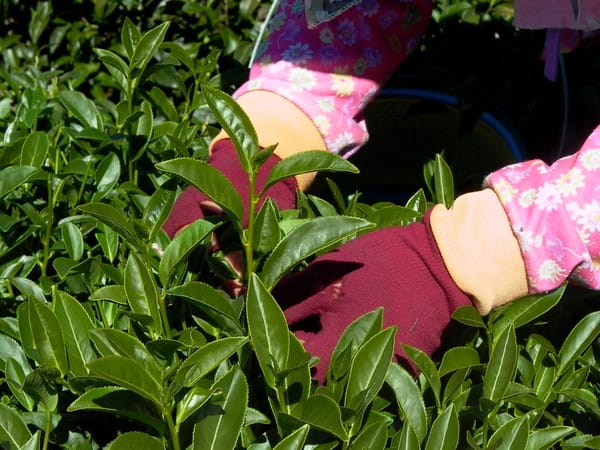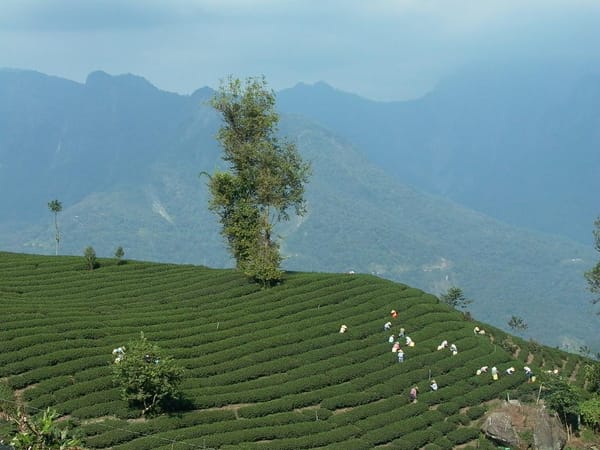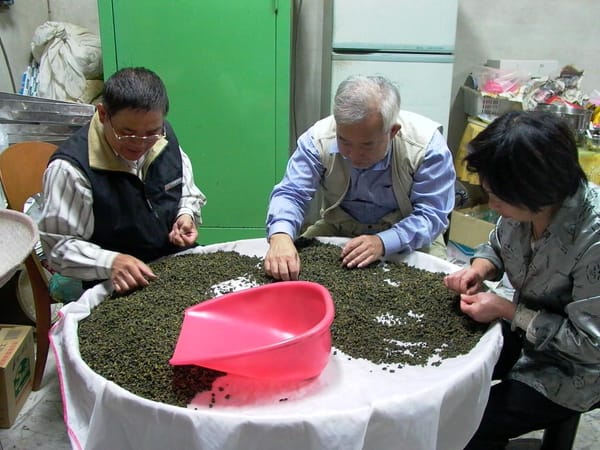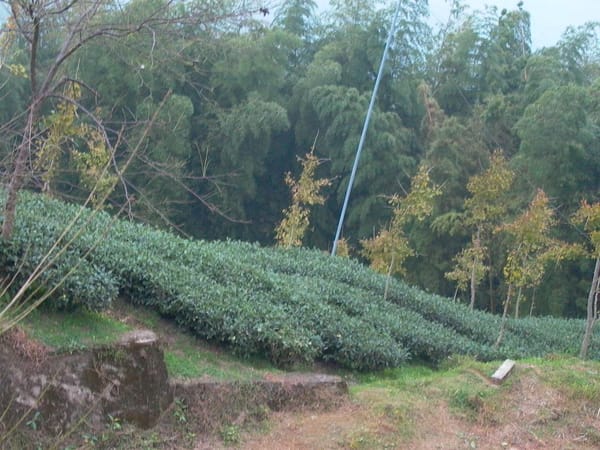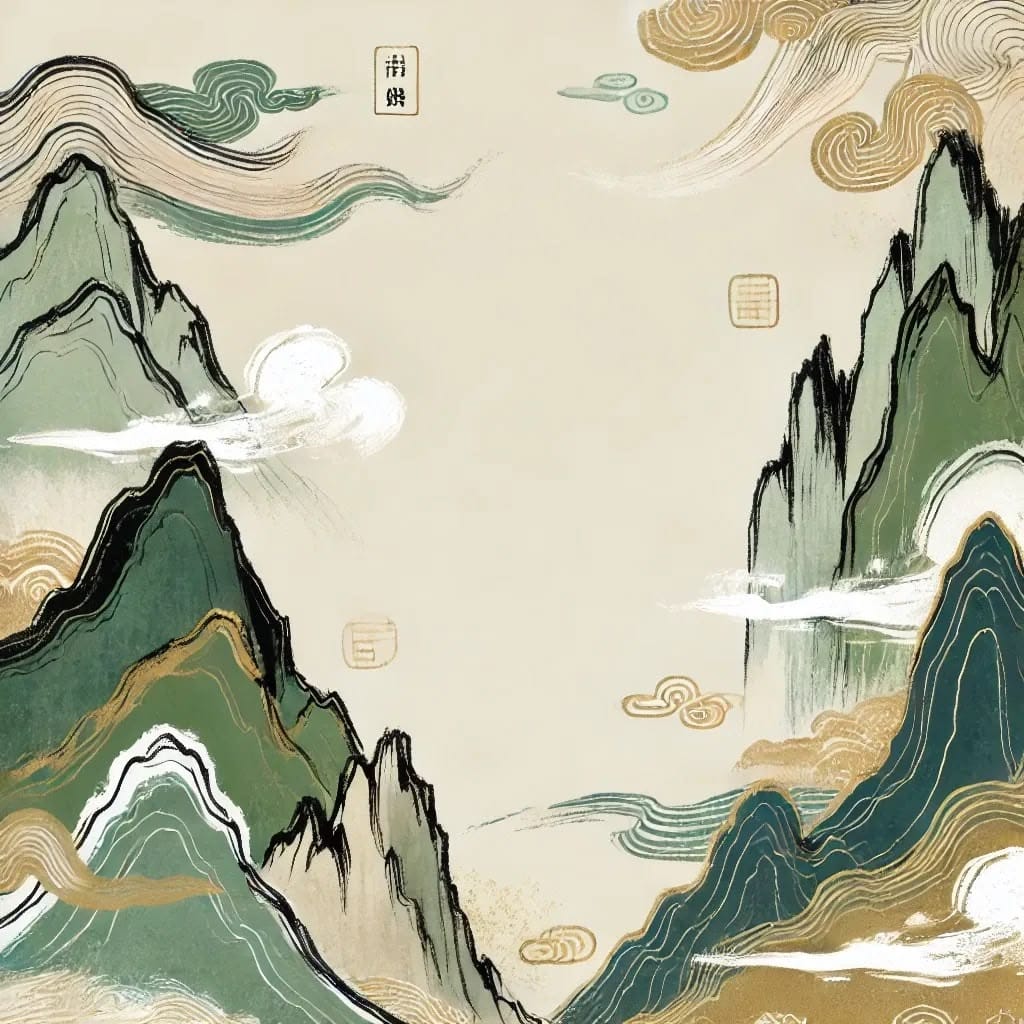When the first rays of sunlight pierce through the mist of Alishan, a delicate morning ritual is already underway in the tea gardens. A skilled “dew beater” holds a bamboo broom, eyes focused on the dew drops clinging to the tea leaves, gently shaking off the moisture that settled overnight. This seemingly simple “dew removal” step is actually the crucial first move in ensuring today’s tea harvest quality.
Unique to Taiwan’s high mountain oolong tea, this harvesting technique distinguishes it from lowland tea cultivation. From dew removal to the precise plucking of the “one bud two leaves,” every step reflects the grower's dedication to quality and the wisdom inherited from generations past.
Let’s explore the mountain tea regions of Taiwan and uncover the science and culture behind these intricate techniques — essential keys to the exceptional quality of high mountain oolong tea.
Dew Removal: Precision in the Morning Light
The Science Behind Dew Removal
While most traditional tea regions consider “noon harvest” ideal, high mountain oolong tea demands a much earlier picking schedule due to intense UV exposure. Tea harvesting begins at sunrise to align with the specific conditions of mountainous environments.
At high altitudes, cooler nighttime temperatures and high humidity cause significant dew formation on tea leaves. If not properly removed, this moisture disrupts water content control, affecting the crucial withering and oxidation stages that follow. Thus, dew removal becomes a non-negotiable ritual before harvest.
The Skill of Dew Removal
The tool used is a specially crafted bamboo broom — flexible yet firm enough to control strength with precision. The “dew beater” is a key figure in the tea garden. Their expertise directly impacts the quality of the day’s harvest.
Although the motion seems simple, it requires remarkable skill. The broom must glide gently over the tea bushes, shaking off dew without damaging the tender leaves. Too soft a touch leaves water behind; too forceful, and the leaves may be torn.
Precision Timing
Timing is everything. Dew removal must occur before evaporation yet not too early, allowing leaves to absorb night nutrients. The optimal window is within 30 minutes before or after sunrise.
Once completed, the leaves take on a healthy sheen — a visual indicator of leaf vitality. As sunlight breaks through, the leaves reach their perfect plucking state, and tea pickers begin their meticulous work.
One Bud Two Leaves: The Golden Standard of Harvest
What It Means and Why It Matters
High mountain oolong tea demands high standards. The “one bud two leaves” rule refers to picking the tea shoot tip (bud) along with the two youngest adjacent leaves — the parts richest in amino acids and aroma compounds.
This standard is not arbitrary; it’s grounded in tea plant physiology. The bud is packed with fragrance, while the first two leaves offer a balanced amount of polyphenols and caffeine — combining to form ideal flavor and aroma.
The Art of Hand Plucking
Every leaf is handpicked — not only to preserve its integrity but to ensure consistency in quality. Skilled pickers must work fast and precisely.
To assist in the process, workers bind a thin steel blade to their index finger — an ingenious tool that snips the stem cleanly without damaging the leaf. It allows for swift and accurate picking without tearing the tissue.
Specialized Attire for Tea Pickers
Tea pickers are fully outfitted for high mountain conditions: wearing straw hats and cloths covering their faces, leaving only the eyes exposed. They carry specially designed baskets on their backs and wrap their hands in cloth, leaving just fingertips free — protecting their skin while preserving dexterity.
The sight of colorful floral scarves dotting the lush green gardens forms a picturesque “splashes of red amid the sea of green” scene.
Harvest Timing and Seasonal Precision
Coordinated with Growth Cycles
Tea harvesting follows a strict rhythm based on plant growth and seasonal climate. For Qingxin Oolong, leaf growth takes about 7 days in spring and winter, and around 5 days in summer and autumn due to warmer temperatures.
This growth cycle affects the harvest interval: Qingxin Oolong is usually picked every 46–47 days in warmer seasons, while Jin Xuan (TTES No. 12) has a faster growth rate and is harvested every 41–51 days.
Altitude Adjustments
Harvest timing also varies with elevation. In high-altitude areas like Hehuanshan, colder temperatures after October prevent new buds from growing, ending winter tea production by September. In mid-high elevations like Alishan, tea can be picked into mid-November.
Understanding these timelines is crucial for consumers. Claims of freshly picked Hehuanshan winter tea in December are unrealistic — awareness of harvest seasons ensures informed choices.
Labor Costs and Wage Structures
Tea Picking Wages
High mountain oolong tea harvest relies heavily on temporary laborers, often from Meishan, Yunlin, Nantou, or Tainan. They are recruited by agents and transported directly to the tea gardens.
Wages are calculated in two ways: by weight (per jin) or by day. In spring and winter, pay per jin ranges from NT$70–100, while in summer and autumn, it's NT$40–60. Daily wages average NT$700–800.
Farmers also pay a commission to agents — often the drivers — and wages are typically paid daily, reflecting the flexibility and immediacy of the work.
Processing Cost Calculations
The conversion ratio from fresh leaves (qing) to rough tea (mao cha) reflects cost. On average, it takes 4 jin of fresh leaves to produce 1 jin of mao cha. For high mountain teas, seasonal variations occur: spring teas may require 4.5–4.7 jin, while winter teas need only 4.
This difference reflects moisture content and compound concentrations, explaining the premium pricing and superior quality of spring and winter teas.
The Mastery of Tea Processing
The Art of Withering
Processing begins immediately after harvesting. Processing sites are usually located next to the gardens. Fresh leaves are spread on the ground to sun wither, managed by experienced tea masters.
Due to intense mountain sunlight, black mesh covers are used to regulate exposure. Masters rely solely on smell to assess the withering stage, adjusting handling based on the tea’s evolving fragrance.
This intuitive process — like a painter capturing light — requires expertise and experience. Proper withering is essential to tea aroma, liquor color, and flavor.
Systematic Quality Management
Benefits of Integrated Production
Taiwanese high mountain tea is often produced and sold directly by farmers. This “integrated production” model reduces intermediary costs and incentivizes growers to manage their tea gardens with care.
Most year-round tasks — weeding, fertilizing, pesticide application, pruning, covering, and irrigation — are done by family members. Temporary workers are only hired during harvest and production seasons, ensuring consistency in garden care.
Relentless Pursuit of Excellence
The unique “mountain essence” of Taiwan’s high mountain tea is achieved through dedicated garden management and strict harvest standards. From dew removal to one bud two leaves, every detail reflects a pursuit of perfection.
Such devotion explains why Taiwanese high mountain oolong tea stands out globally. Each cup carries the labor and mastery of those who cultivate it.
Cultural Heritage in Every Leaf
These harvest techniques are more than technical skills — they’re an integral part of Taiwan’s tea culture. From the morning ritual of dew removal to the precise “one bud two leaves” standard, these traditions still shape the modern tea industry.
When savoring a cup of high mountain oolong tea, consider the farmers who work in mist-covered mountains, day after day, preserving these ancient crafts. Their hands and wisdom capture the essence of the mountains, delivering a taste of the clouds to our cups.
Through their dedication, Taiwan’s high mountain oolong tea continues to shine as a cultural treasure, adding richness and depth to the global tea landscape.

